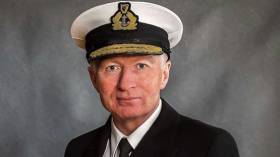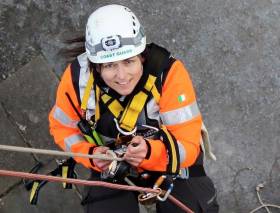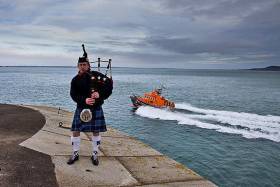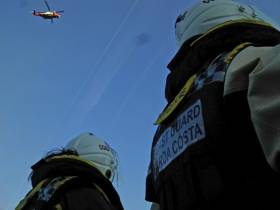Displaying items by tag: Caitriona Lucas
Coastguard Chief Speaks Of Sorrow Over Lost Colleagues Ahead Of Return From EU Secondment
#Coastguard - Irish Coast Guard director Chris Reynolds has paid tribute to the lives lost in the Rescue 116 and Kilkee tragedies ahead of his return from secondment in Somalia.
“The Coast Guard has lost five colleagues to accident and one, Daithi O’Cearbhallain, to cancer. I’ve lost six good friends,” said Reynolds, according to The Irish Sun.
“Not being at home and with my team in the Coast Guard has been very, very difficult,” he added.
“My first intention on my return in October is to visit our volunteer teams, co-ordination centres and helicopter bases to listen and understand how we will move forward.”
Reynolds was seconded to Somalia in July 2016 as part of an EU maritime security mission in the Horn of Africa.
Two months after his departure, coastguard volunteer Caitriona Lucas died during a search operation in Kilkee when her RIB capsized.
Six months later, Rescue 116 crashed at Black Rock in Co Mayo, claiming the lives of its four crew. Capt Dara Fitzpatrick and Capt Mark Duffy were recovered, but the bodies of winch men Paul Ormsby and Ciaran Smith were not found.
Investigation Ongoing Into Death Of Coastguard Volunteer Caitriona Lucas
#MCIB - An official investigation into the death of coastguard volunteer Caitriona Lucas remains ongoing, as the Marine Casualty Investigation Board (MCIB) confirms.
Lucas, a volunteer for the Irish Coast Guard’s Doolin unit, died on 12 September 2016 during a search operation for a missing person in Kilkee, when the RIB in which she and two other volunteers were travelling capsized in a heavy swell.
The MCIB’s interim report outlines the details of the day in question. Investigators’ analysis, conclusions and recommendations will be reserved for the final report.
Wreath For Caitríona Lucas As Dun Laoghaire RNLI Remembers Lives Lost At Sea In Christmas Eve Ceremony
#RNLI - A special wreath will be laid to commemorate the loss of Irish Coast Guard volunteer Caitríona Lucas during Dun Laoghaire RNLI’s annual Christmas Eve ceremony to remember all those who lost their lives at sea in the past year.
The annual commemoration marks the anniversary of the 15 volunteer lifeboat crew members from Dun Laoghaire RNLI who died during a rescue on Christmas Eve in 1895.
The short ceremony is held at the lighthouse at the end of the East Pier in Dun Laoghaire at midday on Christmas Eve. The service includes music, an ecumenical blessing, a reading of a newspaper account printed at the time of the 1895 tragedy, and concludes with a guard of honour for the wreath-bearers as they proceed to sea on the lifeboats to lay the tributes.
The ceremony will last about 20 minutes with upwards of 200 people, including families, expected to walk the pier to join the ceremony at noon.
In previous years, two wreaths have been laid at sea but this year a third will be added in memory of Caitríona Lucas of the Irish Coast Guard unit at Doolin, who died during a search operation on 12 September this year.
A guard of honour will be provided by the Dun Laoghaire Coast Guard Unit and Civil Defence volunteers, while the Dun Laoghaire RNLI lifeboats will carry the wreaths to sea a short distance from the pier.
“This is an especially poignant time of year for many people who have lost loved ones at sea but 2016 will be particularly remembered by all of us involved in rescue services around Ireland,” said Stephen Wynne, lifeboat operations manager with Dun Laoghaire RNLI.
“Caitríona symbolises the commitment we all share for helping others in need; she will not be forgotten.”
Local musician William Byrne will perform a ballad marking the 1895 tragedy, while journalist Fergal Keane will read a newspaper account from that era followed by an ecumenical blessing.
Dublin Fire Brigade piper Paul McNally will play a lament at the East Pier saluting station at the end of the ceremony that has been kindly facilitated by the Dun Laoghaire Harbour Company.
One of the attendees will be Cormac Becton, great grandson of Edward Murphy, a volunteer lifeboat man who lost his life during the rescue of the Palme in 1895.
“For many years as a young child Christmas Eve meant the nativity until I heard the story of my great Grandfather,” said Becton. “Now when I hear winter gales I think of him and the brave lifeboat crew as they rowed out of the harbour.
“The site of the ceremony on Christmas Eve is so close to where they died it isn't hard to imagine the scene and the challenge they faced.’
Due to forecasts of strong winds at the weekend, contingency plans are in place to ensure the ceremony proceeds safely. This may mean the ceremony will be moved closer to the lifeboat station. Attendees will be advised with stewards in place.
Body Recovered In Search For Missing Teacher Off Kilkee
#Kilkee - BreakingNews.ie reports that a body was recovered yesterday (Saturday 24 September) off Kilkee in the search for missing teacher David McMahon.
Hundreds had been involved in the search for the school teacher, who was last seen on 9 September, according to Independent.ie.
The discovery yesterday afternoon came 12 days after the death of Irish Coast Guard volunteer Caitriona Lucas in the same area.
That tragedy occurred when the RIB she and two other coastguard volunteers were on board was flipped over in a heavy swell, three days into the search operation for McMahon off the Co Clare coast.
































































